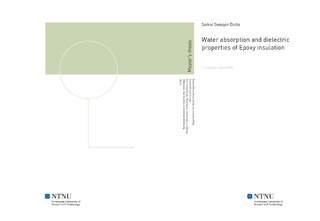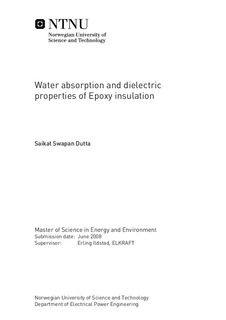| dc.contributor.advisor | Ildstad, Erling | nb_NO |
| dc.contributor.author | Dutta, Saikat Swapan | nb_NO |
| dc.date.accessioned | 2014-12-19T13:51:11Z | |
| dc.date.available | 2014-12-19T13:51:11Z | |
| dc.date.created | 2010-09-04 | nb_NO |
| dc.date.issued | 2008 | nb_NO |
| dc.identifier | 348643 | nb_NO |
| dc.identifier | ntnudaim:4229 | nb_NO |
| dc.identifier.uri | http://hdl.handle.net/11250/256588 | |
| dc.description.abstract | Characterization of Epoxy (diglycidyl ether of Bis-phenol A cured with Tri ethylene Tetra amine) without fillers was done. The Water absorption test at 95°C shows that at saturation the epoxy contains a water concentration of 2.089%. The diffusion coefficient of absorption is calculated as 0.021 cm2/s. The diffusion coefficient of desorption is calculated as 0.0987 cm2/s. The diffusion is almost 5 times faster than absorption. Also the material looses weight as the hydrothermal aging progresses. The water in the sample leads to chain scission which leads to the weight loss. The weight loss is more incase of absorption followed by desorption than only absorption. The chain scission leads to decrease in the mechanical strength by around 45%. The diffusion of water from the samples doesn t affect the mechanical strength of the materials. The glass transition temperature reduces by 20°C with water inside the sample. The diffusion of water out of the sample only increases by around 10°C. The Dielectric response of the material shows that after the water absorption the sample shows high losses at lower frequencies. Also the increase in the real part of the permittivity increases with low frequency. The rapid increase in the real art of the permittivity of the material at lower frequencies can be attributed to a polarization at the electrode due both to accumulation of the charge carriers and to chain migrations. The breakdown test of the samples shows that with water in the sample the breakdown strength of the material decreases by 10 KV, but the material regains its dielectric strength when the water is diffused out. This shows that the chain scission and weight loss of the samples has no or minimum effect on the dielectric strength of the sample | nb_NO |
| dc.language | eng | nb_NO |
| dc.publisher | Institutt for elkraftteknikk | nb_NO |
| dc.subject | ntnudaim | no_NO |
| dc.subject | MSELPOWER Master of Science in Electric Power Engineering | no_NO |
| dc.subject | Elektrisk Energiteknikk | no_NO |
| dc.title | Water absorption and dielectric properties of Epoxy insulation | nb_NO |
| dc.type | Master thesis | nb_NO |
| dc.source.pagenumber | 47 | nb_NO |
| dc.contributor.department | Norges teknisk-naturvitenskapelige universitet, Fakultet for informasjonsteknologi, matematikk og elektroteknikk, Institutt for elkraftteknikk | nb_NO |

